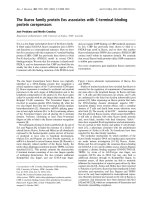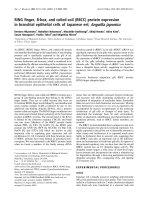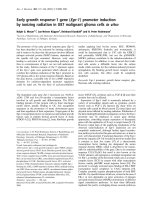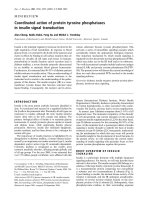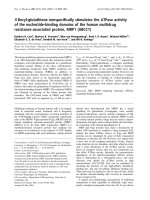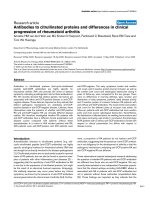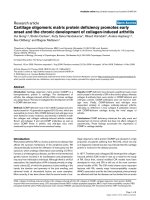Báo cáo y học: " Early Heat shock protein and heat shock factor 1 expression and localization in vaccinia virus infected human monocyte derived macrophage" ppt
Bạn đang xem bản rút gọn của tài liệu. Xem và tải ngay bản đầy đủ của tài liệu tại đây (824.24 KB, 10 trang )
BioMed Central
Page 1 of 10
(page number not for citation purposes)
Journal of Inflammation
Open Access
Research
Heat shock protein and heat shock factor 1 expression and
localization in vaccinia virus infected human monocyte derived
macrophages
Aleksandra Kowalczyk, Krzysztof Guzik, Kinga Slezak, Jakub Dziedzic and
Hanna Rokita*
Address: Jagiellonian University, Faculty of Biotechnology; 7, Gronostajowa St., 30-387 Krakow, Poland
Email: Aleksandra Kowalczyk - ; Krzysztof Guzik - ; Kinga Slezak - ;
Jakub Dziedzic - ; Hanna Rokita* -
* Corresponding author
Abstract
Background: Viruses remain one of the inducers of the stress response in the infected cells. Heat
shock response induced by vaccinia virus (VV) infection was studied in vitro in human blood
monocyte derived macrophages (MDMs) as blood cells usually constitute the primary site of the
infection.
Methods: Human blood monocytes were cultured for 12 – 14 days. The transcripts of heat shock
factor 1 (HSF1), heat shock protein 70 (HSP70), heat shock protein 90 (HSP90) and two viral genes
(E3L and F17R) were assayed by reverse transcriptase-polymerase chain reaction (RT-PCR), and
the corresponding proteins measured by Western blot. Heat shock factor 1 DNA binding activities
were estimated by electrophoretic mobility shift assay (EMSA) and its subcellular localization
analyzed by immunocytofluorescence.
Results: It appeared that infection with vaccinia virus leads to activation of the heat shock factor
1. Activation of HSF1 causes increased synthesis of an inducible form of the HSP70 both at the
mRNA and the protein level. Although HSP90 mRNA was enhanced in vaccinia virus infected cells,
the HSP90 protein content remained unchanged. At the time of maximum vaccinia virus gene
expression, an inhibitory effect of the infection on the heat shock protein and the heat shock factor
1 was most pronounced. Moreover, at the early phase of the infection translocation of HSP70 and
HSP90 from the cytoplasm to the nucleus of the infected cells was observed.
Conclusion: Preferential nuclear accumulation of HSP70, the major stress-inducible chaperone
protein, suggests that VV employs this particular mechanism of cytoprotection to protect the
infected cell rather than to help viral replication. The results taken together with our previuos data
on monocytes or MDMs infected with VV or S. aureus strongly argue that VV employs multiple
cellular antiapoptotic/cytoprotective mechanisms to prolong viability and proinflammatory activity
of the cells of monocytic-macrophage lineage.
Published: 24 October 2005
Journal of Inflammation 2005, 2:12 doi:10.1186/1476-9255-2-12
Received: 29 April 2005
Accepted: 24 October 2005
This article is available from: />© 2005 Kowalczyk et al; licensee BioMed Central Ltd.
This is an Open Access article distributed under the terms of the Creative Commons Attribution License ( />),
which permits unrestricted use, distribution, and reproduction in any medium, provided the original work is properly cited.
Journal of Inflammation 2005, 2:12 />Page 2 of 10
(page number not for citation purposes)
Background
Manipulation of the immune system, especially interfer-
ence with specific components of the apoptotic response
of the infected cells is essential for a virus to replicate and
to disseminate in a host.
Vaccinia virus belongs to the poxviruses super-family, a
group of large DNA viruses known from their exclusive
propagation outside the nucleus in the cytoplasm of the
infected cell [1]. Vaccinia virus infections are commonly
associated with a generalized host cell protein and nucleic
acids synthesis inhibition, depending on time and an
infectious dose. Despite the observed shutdown of host
transcriptional and translational mechanisms and selec-
tive expression of many viral genes, several eukaryotic
proteins are transiently induced or activated by poxvi-
ruses, e.g. transcription factors [2], cytokines [3,4], heat
shock proteins [5] and antioxidant enzymes [6]. Moreo-
ver, although mainly necrotic, vaccinia virus is opposing
the apoptosis due to several anti-apototic genes present
and expressed from its genome [7,8].
Stress conditions like heat shock, infections, radiation,
and exposure to chemicals induce increased levels of heat
shock proteins in many cell lines [9]. The heat shock pro-
teins can be induced in vitro following infection by a vari-
ety of viruses [10] such as Ad5 and HSV-1 which have
been shown to induce synthesis of one of the main heat
shock proteins, HSP70. Vaccinia virus was already found
to be a potent inducer of HSP70 in mice [11,12]. The role
of HSP70 in vaccinia virus infection has not been eluci-
dated so far, however the results of the earlier studies in
vaccinia virus infected U937 cells and primary macro-
phages suggest its role in viral protein folding and virus
assembly [5]. Moreover, in vivo studies in mice reveal lack
of the influence of infection on viral life cycle [12]. Obvi-
ously, HSPs constitute specific chaperons for the viral pro-
teins necessary to secure proper folding, translocation and
formation of multi-component complexes of the viral
proteins. Recent investigations indicate that the heat
shock proteins exert suppression of the apoptosis [13-15]
and therefore might support vaccinia virus infection.
Induction of the heat shock protein synthesis requires ear-
lier activation of heat shock factors. HSF1 is assumed to be
the main mediator of the cellular stress response, which
binds to the heat shock promoter element (HSE) [16,17].
It is believed that in normal conditions monomers of
HSF1 exist inactive in the cytoplasm in large complexes
with other heat shock proteins, e.g. HSP90, and HSP70.
Upon stress, when the heat shock proteins are needed,
HSF1 undergoes trimerization, subsequent translocation
into the nucleus and binding to the heat shock elements
within the regulatory sequences of the heat shock protein
genes [15,18].
To understand further the role of vaccinia virus in the
course of the infection, the heat shock response was stud-
ied in human blood monocyte derived macrophages
infected with the vaccinia virus Western Reserve strain.
Methods
Cell culture
Peripheral blood leukocytes (PBL) were isolated by stand-
ard Ficoll-Paque (Pharmacia, Uppsala, Sweden) gradient
centrifugation from the blood of healthy donors. The cells
were cultured at the concentration of 2 × 10
7
of PBL cells
per 5.5 cm dish for protein harvesting or at the concentra-
tion of 8 × 10
6
of PBL cells per 3.5 cm dish for immuno-
cytochemical analyses. The cells were cultured for 10–14
days in RPMI medium (Gibco) with 10% human serum
(AB serotype); medium was changed every 48 hours until
the monocytes reached adherence. The adherent mono-
cytes constitute 10 % of the total PBLs placed on the dish.
Human hepatoma HepG2 cells were cultured in DMEM
with 10% FCS in 60 mm-diameter culture dishes for 48
hours before infection or heat shock.
Virus propagation
The vaccinia virus Western Reserve strain was propagated
in VERO-B4 cells (DSMZ, Germany) infected at multiplic-
ity of infection (MOI) of 1 (one plaque forming unit, pfu,
per cell) maintained in MEM supplemented with 4%
heat-inactivated FCS. Infected cells were harvested when
the maximum cytopathic effect was observed and infectiv-
ity was estimated by a quantal infectivity assay on VERO-
B4 cells [19] and a standard plaque assay. Human macro-
phages were infected with the virus at multiplicity of infec-
tion 1 or 5. Infected cells were washed after 1 h of virus
adsorption and fresh medium added.
Heat shock
The heat shock was performed in 42°C in the water bath
for one hour, followed by 2–4 hours recovery at 37°C.
Protein isolation
The cells were washed with 1 ml cold PBS and harvested
to the Eppendorf 2 ml tubes in 1–2 ml of PBS. The har-
vested cells were centrifuged at 250 × g for 5 min. The cell
pellet was suspended either in 400 µl of the resuspension
buffer for isolation of the nuclear and cytoplasmic frac-
tions of proteins according to the Suzuki method [20], or
in 150 µl of the extraction buffer (50 mM Tris pH 8.0, 10
mM CHAPS, 2 mM EDTA, 1 mM Na
3
VO
4
, 5 mM DTT, 1
mM PMSF, 10% glycerol) for whole cell extracts [21].
According to the Suzuki method, the nuclear fraction con-
tains all nuclei, and the remaining supernatant is termed
"cytoplasmic fraction". Contamination of the nuclei with
cytoplasm was excluded based on lactate dehydrogenase
activity measurements using a LDH detection kit from
Boehringer Mannheim.
Journal of Inflammation 2005, 2:12 />Page 3 of 10
(page number not for citation purposes)
Protein concentrations were measured using the BCA
assay (Sigma) based on bicinchoninic acid [22]. The
absorbance was measured at 562 nm in SpectraMax 250
microplate reader (Molecular Devices).
Western blot
Equal amounts of protein extracts (10 µg/lane) were sep-
arated by SDS-PAGE according to the protocol described
by Laemmli [23]. The protein transfer was performed in a
semi-dry blotting system (Fastblot B31, Biometra) in the
transfer buffer (25 mM Tris pH 8.3, 0.2 M glycine, 20%
methanol, v/v) at 35 V for 30 min. Equal loading of sam-
ples, and even transfer, were confirmed by staining the
membranes with Ponceau S. The membrane (Hybond,
Amersham Pharmacia) was blocked with 5% powdered
milk in TST buffer (10 mM Tris HCl pH 7.5, 0.9 % NaCl,
0.05 % Tween 20) for 1.5 h, followed by a 20-min wash
in the TST buffer. The membrane was incubated either
with the primary anti-HSF1 (H-311, sc-9144), or anti-
HSP70 (K-20, sc-1060), or anti HSP90 antibodies (H-114,
sc-7947) from Santa Cruz Biotechnology, in 1:1000 dilu-
tion in the TST buffer with 2 % BSA for 1 h. The mem-
brane was then washed four times in TST buffer for 15
min. Secondary anti-rabbit IgG antibodies coupled to
horseradish peroxidase (Amersham Pharmacia) were
diluted 1:5000 in TST buffer with 2 % BSA. The mem-
brane was incubated with the secondary antibodies for 1
hour, followed by four washes of 15 min. in TST buffer.
The ECL-plus kit (Amersham Pharmacia) was used to vis-
ualize the protein. The membranes were exposed into X-
ray films for 10 minutes to 1 hour, and the films were
developed.
Electrophoretic mobility shift assay
A DNA mobility shift assay was carried out as described by
Duyao [24]. The double-stranded oligonucleotides con-
taining the HSF binding site (5'-CTAGAAGCTTCTA-
GAAGCTTCTAGAA-3') were an "optimal" heat shock
element (HSE) containing five perfect inverted nGAAn
repeats from the human hsp70 [25]. DNA fragments were
labeled using Klenow polymerase and [α-32P]dCTP by
filling 5'-overhangs of four bases at both ends after
annealing. Equal amounts of protein (5 µg) in 10% glyc-
erol were incubated at room temperature for 30 min. with
0.5 ng of the labeled dsDNA oligonucleotide in the pres-
ence of 2 µg of poly(dI-dC) in 10 mM Tris pH 7.5, 50 mM
NaCl, 1 mM EDTA and 0.1 mM DTT in a total volume of
20 µl. For supershift analysis, the rabbit polyclonal anti-
bodies against human HSF1 (H-311, sc-9144X) from
Santa Cruz Biotechnology were also preincubated with
protein extracts in 1:20 dilutions. Incubation mixtures
were electrophoresed on 4.5% nondenaturing polyacryla-
mide gel in 0.5 × TBE. The dried gels were analyzed by
autoradiography.
RNA extraction and RT-PCR
Total RNA was extracted from cultured cells using Trizol
reagent (Gibco). RNA samples (2 µg) were used for cDNA
synthesis reactions in a total volume of 20 µl containing
10 µl of each RNA sample, 0.5 µg oligo (dT)12–18 primer
(Gibco) and 200 U of SuperScript II RNAse H-Reverse
Transcriptase (Gibco) according to the protocol provided
with the enzyme. Although some RNA samples were
treated with RNase-free DNase to remove all genomic
DNA prior to the RT reaction, similar results were received
using DNase untreated RNA preparations. The PCR reac-
tions were done using F105S Taq polymerase (Polygen) in
the mixes containing: 5 µl 10 × PCR buffer, 1 µl 10 mM
dNTPs, 2 µl of each primer, 50 mM KCl, 1.5 mM MgCl
2
,
2.5 U of (1 µl) Taq polymerase, 2 µl cDNA and 37 µl ster-
ile water. Reactions were carried out at the following con-
ditions: 94°C for 1 min, 60°C for 1 min, and 72°C for 1.5
min for 30 cycles (hsp70 and hsf1) or 95°C for 1 min,
50°C for 1 min, and 72°C for 1.5 min for 30 cycles
(hsp90α) or 94°C for 1 min, 55°C for 1 min, and 72°C for
1.5 min for 30 cycles (E3L, F17R, and β-actin). Each ther-
mal profile was ended with the final extension at 72°C for
15 min. The reaction products were then resolved on non-
denaturing 2% agarose gel and visualized by staining with
ethidium bromide. The primer sequences are listed in
Table 1. The primers were designed to match sequences in
separate exons (except for the hsp70 encoded by a single
exon) to avoid the contribution of genome-templated
product in the signal analysis.
Immunofluorescence cell staining
The cells were cultured on sterile glass cover slips
mounted in 3.5 cm culture dishes. Cells were fixed with
3% paraformaldehyde in PBS at 37°C for 15 min and per-
meabilized with 0.1% Triton-X-100 in PBS for 5 min at
room temperature. Nonspecific binding sites were
blocked with 3% bovine serum albumin solution in PBS
and cells were stained with the anti-human HSF1 (H-311,
sc-9144) rabbit polyclonal antibodies (Santa Cruz Bio-
technology) in 1:200 dilution. The secondary sheep anti-
rabbit Cy3 conjugated IgGs (Sigma, C2306) were used in
1:200 dilution. Nuclear DNA was additionally stained
with Hoechst 33258 (Molecular Probes) at a concentra-
tion 0.5 µg/ml for 10 min at room temperature and then
washed three times with PBS. Cover slips were mounted
on microscopic glass slides using Vectashield (Vector Lab-
oratories) to prevent fading of the fluorescent dye. Micro-
photographs were taken using a Leitz Orthoplan
microscope with an epifluorescence and phase-contrast
optics equipped with the Nikon FX-35DX camera on high
sensitivity Kodak TMAX 3200 films. From one spot both,
phase-contrast pictures as well as fluorescence pictures
were taken.
Journal of Inflammation 2005, 2:12 />Page 4 of 10
(page number not for citation purposes)
Results
Changes in the heat shock factor 1 and the heat shock
protein mRNAs content during vaccinia virus infection of
human blood macrophages
The levels of HSF1, HSP70 and HSP90 mRNAs were deter-
mined by RT-PCR in control and virus-infected macro-
phages. In most unstressed cells, neither HSP70, nor
HSP90 mRNA were detected (Fig. 1A), although in some
cultures a basal level of both transcripts was visible (Fig.
1B). This heterogeneity was probably due to individual
features of blood or serum donors. In contrary, HSF1
mRNA was constitutively accumulated in all examined
cultures. The analysis showed no increase of the HSF1
transcripts up to 48 h p.i. (with a low infectious dose, 1
pfu/cell), similarly to the heat shock response when HSF1
mRNA is not induced (Fig. 1A). However, biphasic kinet-
ics of HSF1 mRNA is observed after high dose infection (5
pfu/cell) with the minimum at 6 to 24 h p.i. correspond-
ing to the maximal viral gene transcription (Fig. 1B) [5].
Subsequent decline in viral transcription was followed by
increased HSF1 mRNA content.
HSP70 mRNA increased early upon infection with a high
vaccinia virus dose, and clear decrease was found fairly
late, at 96 hours p.i. The transcript increase after low infec-
tious dose was slowly reaching the maximum at 48 h p.i.
The kinetics of HSP90 mRNA increase upon high vaccinia
virus dose was similar to that of HSP70 mRNA, however
its level decreased earlier than the levels of HSP70 tran-
script, as this was observed already at 72 hours p.i. At MOI
1, HSP90 mRNA increase was slow, similar to the increase
of HSP70 mRNA. HSP70, HSP90 and HSF1 transcripts
estimated after the heat shock of the macrophages are also
included for comparison and β-actin transcript is shown
as a control.
Viral gene expression in the macrophages
In order to check the viral infection itself, two viral genes
were chosen: early gene E3L, responsible for the vaccinia
virus antiapoptotic defence on the interferon pathway
[26], and late viral gene, F17R, the product of which takes
part in the mature virion assembly [27]. The RT-PCR of
the viral genes showed an increased amount of E3L mRNA
at 4 h p.i., which was maintained up to 96 h p.i. F17R
mRNA was detected also at 4 h p.i. but increased at 14 h
and maintained elevated up to 96 h p.i. (Fig. 2). The
results evidenced, that late viral DNA replication had not
been stopped in the macrophages. Moreover, increased
and persistent levels of E3L mRNA support our conclu-
sion on resistance to apoptosis elicited in the infected
cells.
HSF 1 protein activity and localization in the vaccinia virus
infected macrophages
Heat shock factor 1 DNA binding activity was analyzed in
the nuclear and whole cell extracts of macrophages by an
electrophoretic mobility shift assay. EMSA showed pro-
tein binding to the heat shock element in the control, at
16, and 24 hours of vaccinia virus infection (Fig. 3A).
Supershift analysis of the whole cell extracts from vaccinia
virus infected cells and the extracts from uninfected cells
confirmed that heat shock factor 1 was present in equal
quantities (Fig. 3A). However, nuclear proteins isolated at
16 h p.i. (Fig. 3A, lane 5) did not form the clear shifted
antibody-HSE complex, suggesting that the epitopes rec-
ognized by the polyclonal antibodies are obscured by
other proteins. Similar DNA-protein complex, without
the antibodies against HSF1 added, was observed only in
vaccinia virus-infected and heat shock treated human
hepatoma HepG2 cell line (Fig. 3B).
Although HSF1 protein content did not change in the
whole cell extracts after vaccinia virus infection and dur-
ing the heat shock response (Fig. 4A), more HSF1
Table 1: Sequences of the primers used in the RT-PCR reaction and the size of the amplified products of human and viral genes
Gene of interest Size of the product Primer orientation Primer sequence
β-actin 307 bp Forward
Reverse
5' AGCGGGAAATCGTGCGTG 3'
5' GGGTACATGGTGGTGCCG 3'
hsf1 577 bp Forward
Reverse
5' ATGGCCAGCTTCGTGCG 3'
5' ACAGCATCAGGGGCGTA 3'
hsp70 590 bp Forward
Reverse
5' TTTGACAACAGGCTGGTGAACC 3'
5' GTGAAGGATCTGCGTCTGCTTGG 3'
hsp90 1498 bp Forward
Reverse
5' GCTGTGCCGTTGGTCCTGTGC 3'
5' GGTTCTCCTTCATTCTGGTGC 3'
E3L 360 bp Forward
Reverse
5' TATATTGACGAGAGTTCTGAC 3'
5' ACTCATTAATAATGGTGACAGG 3'
F17R 283 bp Forward
Reverse
5' ATTCTCATTTTGCATCTGCTC 3'
5' AGCTACATTATCGCGATTAGC 3'
Journal of Inflammation 2005, 2:12 />Page 5 of 10
(page number not for citation purposes)
accumulated in the nuclei of infected cells than in the
nuclei of control cells, especially at 48 h p.i. (Fig. 4B and
4C) as Western blot analysis revealed. The analysis with a
polyclonal anti-HSF1 serum shows two HSF1 bands with
mobilities of approximately 70 and 80 kDa, which differ
in phosphorylation state (Fig. 4C) [28]. The hyperphos-
phorylation of HSF1 and translocation of the factor into
the nucleus of vaccinia virus-infected macrophages was
clearly seen at 24 h p.i. (Fig. 4C).
Indirect immunocytochemical staining of macrophages
with anti-HSF1 antibodies (the secondary antibodies con-
jugated with Cy3) showed prevalent nuclear and weak
cytoplasmic localization of the factor in the control cells
(Fig. 5). Even more protein was observed in the nuclei and
cytoplasm of vaccinia virus infected cells at 24 h p.i. The
percentage of the cells containing HSF1 exclusively in
their nuclei was calculated based on the immunocyto-
chemical staining of the cells and mean values of at least
100 cells randomly selected on each sample were 24%
and 46% for infected and control cells respectively.
HSP70 protein increases during infection and transiently
accumulates in the nucleus
HSP70 protein content increased during the first 14 hours
of infection (Fig. 6A) but no as much as it was shown for
the heat shock treated macrophages. The increase reflected
earlier changes in HSP70 mRNA content shown in Fig. 1.
Prevalent nuclear accumulation of the protein was
observed fairly late at 24 and 48 hours p.i. (Fig. 6B), while
no change was found at 4 h p.i. (Fig. 6C). Data from the
heat shock treated and the heat shock recovered cells are
also included (Fig. 6C).
HSP90 protein does not increase during infection but
transiently locates in the nucleus
HSP90 protein content did not change during in vitro
infection as estimated by Western blot in the whole cell
RT-PCR analysis of the heat shock factor 1 and heat shock proteins in vaccinia virus infected human blood macrophagesFigure 1
RT-PCR analysis of the heat shock factor 1 and heat
shock proteins in vaccinia virus infected human blood
macrophages. HSF1, HSP70, HSP90α and β-actin mRNAs
were measured at 3, 6, 16, 24, 48, 72 and 96 hours p.i. PCR
data come from a single representative experiment being one
of three separate experiments using the cells from healthy
donors. Vaccinia virus (V) infection was carried out at MOI 1
(A) and 5 (B), control (C). HS – heat shock at 42°C for 1 h
plus recovery at 37°C for 2 h. β-actin gene product was used
as a control.
Viral early (E3L) and late (F17R) genes expression in the infected human adherent monocytesFigure 2
Viral early (E3L) and late (F17R) genes expression in
the infected human adherent monocytes. Two vaccinia
virus transcripts of E3L and F17R genes and of the cellular
gene, β-actin, as a control, were estimated by RT-PCR. Rep-
resentative results of three independent experiments are
shown.
Journal of Inflammation 2005, 2:12 />Page 6 of 10
(page number not for citation purposes)
Vaccinia virus-induced HSE binding activity in macrophages and a human hepatoma cell lineFigure 3
Vaccinia virus-induced HSE binding activity in macrophages and a human hepatoma cell line. (A) Macrophages
were infected with vaccinia virus (V) with 5 pfu/cell and cultured for 16 or 24 hours (supershift assay). Lane 1 – NE from
infected macrophages at 16 h p.i., lane 2 – WCE from control macrophages, lane 3 – WCE from infected macrophages at 16 h
p.i., lane 4 – WCE from infected macrophages at 24 h p.i.; lanes 5–8 – as lanes 1–4 plus preincubation with 1:20 dilution of anti-
bodies against HSF1 (aHSF1). (B) HepG2 cells (3 × 10
6
) were infected with vaccinia virus at MOI 1 for 24 h or heat shock
treated (44°C, 20 min) or heat shock treated and recovered for 2 or 4 h at 37°C (shift assay). Lane 1 – control cells, lane 2 –
heat shock treated, lane 3 – heat shock treated and recovered for 2 h, lane 4 – heat shock treated and recovered for 4 h, lane
5 – vaccinia virus infected for 24 h. O – ds oligoDNA (free HSE) incubated without proteins. Exposure time: 6 days (A) and 18
h (B). A single representative experiment being one of four separate experiments is shown.
Journal of Inflammation 2005, 2:12 />Page 7 of 10
(page number not for citation purposes)
extracts (Fig. 7A). However, early (at 14 hours p.i.)
increase in the nuclear content of the protein was found
similarly to the results obtained for HSP70 protein (Fig.
7B). Additional analysis of HSP90 content in the heat
shock treated and the heat shock recovered macrophages
revealed that the heat shock similarly to the vaccinia virus
infection, cause HSP90 protein translocation into the
nucleus and the effect was clearly seen 4 hours after the
heat shock (Fig. 7C).
Discussion
Several cellular proteins are used by poxviruses and one of
the examples is HSP70, which aggregates with viral pro-
teins in the cytoplasm [5]. Although vaccinia virus life
cycle does not appear to depend on HSP70 expression
[12], the HSP70 transcripts as well as the protein increase
significantly in human macrophages at 4 to 24 h p.i., as
shown by us and others [5]. It has been well documented
that protection against stress-induced apoptosis depends
on the chaperone function of HSP70 [14]. Therefore, the
results presented in this study indicate that HSP70 might
be one of the factors responsible for the survival of VV-
infected macrophages. In contrast to the results presented
by others we also suggest a more important role of the
nuclear pool of HSP70 [5]. Our data showing the predom-
inant nuclear localization of HSP70 do not support the
hypothesis on the possible role of HSP70 in folding of
viral proteins [5], but speak rather in favor of its protective
role in biogenesis of ribosomes within the nucleoli of the
infected cells [29].
The role of HSP90 in viral infection, especially its nuclear
accumulation (Fig. 7), remains unclear. Our earlier stud-
ies [4] have already revealed the stimulatory effect of the
vaccinia virus infection on IL-10 gene expression in
human blood elutriated monocytes. The finding stays in
agreement with the data on the enhancement of the hsp90
gene expression by IL-10 in a human hepatoma HepG2
cell line and peripheral blood mononuclear cells [30]. The
lack of HSP90 protein induction in the vaccinia virus
Western blot analysis of subcellular localization of HSF1 in vaccinia virus infected macrophagesFigure 4
Western blot analysis of subcellular localization of
HSF1 in vaccinia virus infected macrophages. Whole
cell extracts (WCE) (A), nuclear extracts (NE) (B, C) and
cytoplasmatic fraction(CYT)(B, C) of vaccinia virus infected
macrophages were analysed by Western blot. C – control,
HS – heat shock. Vaccinia virus (V) infection was carried out
at MOI 5.
Vaccinia virus-induced HSF1 redistributionFigure 5
Vaccinia virus-induced HSF1 redistribution. Cells unin-
fected (control) or infected for 24 h (MOI 5) were fixed and
allowed to react with anti-human HSF1 antibodies (A) or
stained with Hoechst 33258 (B). Panels A, B – epifluores-
cence, C – phase-contrast picture of the same cells. Repre-
sentative images of three independent experiments are
shown. The inserted bar – 20 µm.
Journal of Inflammation 2005, 2:12 />Page 8 of 10
(page number not for citation purposes)
infected cells was already found by others [10,31]. How-
ever, these authors [10] failed to detect an increased
induction of HSP70, and this observation stays in contrast
to our results (Fig. 6). Moreover, differential kinetics of
HSP70 and HSP90 mRNA levels following exposure to a
heat shock in human blood adherent monocytes was also
found [32], therefore the heat shock response seems to be
similar in this aspect to the vaccinia virus infection.
HSF1 is not a stress-inducible protein, neither is its expres-
sion level coupled to the rate of expression of the heat
shock genes [33]. Although the vaccinia virus infection
causes transient increase of HSF1 mRNA, no increase in
HSF1 protein content is found, probably due to the insta-
bility of its mRNA. On the other hand, the decrease in
HSF1 mRNA observed at the beginning of the infection
does not severely affect the protein content because of a
fairly long half life time of HSF1 protein [15]. The small
decrease in HSF1 content found by us on the third day p.i.
(Fig. 4A), might result from limited cellular protein syn-
thesis observed during the prolonged viral infection.
In resting cells, HSF1 is predominantly found in a diffuse
cytoplasmic and nuclear distribution, and after the heat
shock it relocates rapidly to form large and irregularly
shaped nuclear granules [34]. These nuclear structures,
referred to as the HSF1 stress granules, can be induced by
various stresses, and are detected in different cell types
[35]. In resting human cells the predominant nuclear
localization of HSF1 before and after the heat shock has
been reported [36], and our analysis suggests that HSF1
partially remains in the cytoplasm of the infected
macrophages (Fig. 5). Active translocation of several pro-
teins from the nucleus to serve as transcription factors was
already found for some viruses, which conduce their life
cycle in the cytoplasm. Recent findings provide evidence
that YY1 translocates into the cytoplasm of the vaccinia
virus infected cells to serve as an activator of one of vac-
cinia late genes [37]. The factor is recruited to the cyto-
plasm of the vaccinia virus-infected macrophages through
an exportin-1 system, sensitive to leptomycin B [38].
Changes in HSP70 content in vaccinia virus infected macrophagesFigure 6
Changes in HSP70 content in vaccinia virus infected
macrophages. Whole cell extracts (WCE) (A), nuclear
extracts (NE) (B, C) and cytoplasmatic fraction (CYT) (B, C)
of vaccinia virus infected macrophages were analysed by
Western blot. C – control, HS – heat shock (proteins
extracted after 4 hours recovery from heat shock). Vaccinia
virus (V) infection was at MOI 5.
HSP90 content in vaccinia virus infected macrophagesFigure 7
HSP90 content in vaccinia virus infected macro-
phages. Whole cell extracts (WCE) (A), nuclear extracts
(NE) (B, C) and cytoplasmatic fraction (CYT) (B, C) of vac-
cinia virus infected macrophages were analysed by Western
blot. C – control, HS – heat shock, HS
4
– heat shock and 4 h
recovery. Vaccinia virus (V) infection was at MOI 5.
Journal of Inflammation 2005, 2:12 />Page 9 of 10
(page number not for citation purposes)
The vaccinia virus infection resulted in massive recruit-
ment of the HSE-binding activity in the investigated cells
(Fig. 3). Surprisingly, only a small fraction of this activity
was recognised by the anti-HSF-1-specific antibody, and
the 'supershifted' fraction was constitutive (Fig. 3A). We
speculate that the observed HSE-binding activity contains
HSF1, but the most of its epitopes were obscured by the
virus-induced chaperones, which accumulated in the
nuclei of the infected macrophages in abundant amounts.
The speculation is supported by the results presented in
Fig. 6B, which demonstrate the preferential nuclear
accumulation of HSP70 and the lack of cytoplasmic
accumulation of HSP70 (Fig. 6B) after the vaccinia virus
infection. Consequently, the observed HSE-binding activ-
ity was much stronger in the nuclear extracts (lane 1) than
in the whole cell extracts (lanes 2–4) (Fig. 3A). The similar
HSE-binding activity was observed in the extracts from the
vaccinia-infected or the heat shocked HepG2 cells (Fig.
3B). It is possible that mostly HSP70 and HSP90 recognise
and strongly bind the preformed HSF1-HSE complexes in
vitro [39]. It seems that the massive nuclear accumulation
of stress chaperones is characteristic for the vaccinia virus-
infected cells.
MDMs used in our study, survived the VV infection
although the virus-induced stress reaction developed
accordingly to the infecting dose (Fig. 1). The cytoprotec-
tive role of the stress seems evident, since the infected
macrophages effectively accumulated different mRNA
species for at least 4 days post infection. Routine fluores-
cent microscopic examination revealed no propidium
iodide permeability of the infected cells (not shown). We
have previously described that human peripheral blood
monocytes retain viability following the infection with
low doses of VV [4]. Moreover, in the same experimental
conditions HSP70 protected the monocytes against Sta-
phylococcus aureus-induced apoptosis [40]. Apparently, the
challenge by S. aureus might be less tolerable for
monocytes/macrophages than the one caused by vaccinia
virus. It is due to the staphylococcal α-toxin, which is
known to initiate this type of monocyte apoptosis [41].
The poxvirus-induced cytoprotection seems to be much
more effective than the other types of stress reaction. Such
conclusion can be drawn from the predominant nuclear
localization of HSP70 induced in human cells by the vac-
cinia virus. The predominant nuclear localization of
HSP70 was also observed in the respiratory syncytial virus
infected cells [42]. The nuclear stress reaction has been
found essential for protection also against hypoxia and
oxidative stress [43]. Viral antiapoptotic proteins like the
recently discovered F1L [44] certainly act in concert with
Bcl-2 [45] and stress-induced chaperones to prolong
lifespan of the infected cells. Little is known about the
impact of pathogen-induced monocyte/macrophage
apoptosis in immune system. Persistence of professional
immune cells harboring intracellular pathogen in a circu-
lation or a lymph tissue seems detrimental for immunity
for at least two reasons: firstly, the immune response is
deregulated by cytokines and impaired antigen presenta-
tion; secondly, the cells were proposed to serve as virus
incubators [46].
Cells of monocytic lineage have recently been recognised
as a crucial model to study virus-host interactions due to
unique capability of these cells to cross-present
endocytosed antigens, especially in the context of chaper-
one proteins [47]. Further understanding of the heat
shock response during the vaccinia virus infection may
improve strategies of application of vaccinia genome in
recombinant gene expression, vaccination and gene
therapy.
Declaration of competing interests
The author(s) declare that they have no competing
interests.
Authors' contributions
AK carried out monocyte isolation and culture and partic-
ipated in the immunoassays, KG participated in the
design of the study and carried out RT-PCR analysis, KS
participated in the gel shift analysis and carried out immu-
nocytochemical analyses, JD participated in the immu-
noassays, HR conceived the study, participated in its
design and coordination, participated in the gel shift anal-
ysis and drafted the manuscript. All authors read and
approved the final manuscript.
Acknowledgements
This work was supported by grant 6P04A 02116 from the Committee of
Scientific Research (Warsaw, Poland).
References
1. Moss B: The viruses and their replication. In Fields Virology 2nd
edition. Edited by: Knipe DM, Howley PM. Philadelphia: Lippincott
Williams and Wilkins; 2001:2849-2883.
2. Muller JM, Ziegler-Heitbrock HWL, Baeuerle PA: Nuclear factor
kappa B, a mediator of lipopolysaccharide effects. Immunobiol
1993, 187:233-256.
3. Rokita H, Kupiec T, Guzik K, Koj A: Vaccinia virus-regulated
acute phase cytokine production in human fibroblasts, U937
cells and endothelium. Mediat Inflammation 1998, 7:73-78.
4. Slezak K, Guzik K, Rokita H: Regulation of interleukin 12 and
interleukin 10 expression in vaccinia virus-infected human
monocytes and U-937 cell line. Cytokine 2000, 12:900-908.
5. Jindal S, Young RA: Vaccinia virus infection induces a stress
response that leads to association of Hsp70 with viral
proteins. J Virol 1992, 66:5357-5362.
6. Dobierzewska A, Wator G, Rokita H: Changes in manganese
superoxide dismutase mRNA content and enzymatic activ-
ity in vaccinia virus infected human astrocytoma U-373 cell
line. In Superoxide Dismutases: Recent Advances and Clinical Applications
Edited by: Edeas MA. Paris-Tokyo: Editions Mel Paris; 1999:168-173.
7. McFadden G, Barry M: How Poxviruses oppose apoptosis. Sem-
inars in Virol 1998, 8:429-442.
8. Nash P, Barret J, Cao J-X, Hota-Mitchell S, Lalani AS, Everett H, Xu
X-M, Robichaud J, Hnatiuk S, Ainslie C, Seet BT, McFadden G:
Immunomodulation by viruses: the myxoma story. Immunol
Rev 1999, 168:103-120.
Publish with BioMed Central and every
scientist can read your work free of charge
"BioMed Central will be the most significant development for
disseminating the results of biomedical research in our lifetime."
Sir Paul Nurse, Cancer Research UK
Your research papers will be:
available free of charge to the entire biomedical community
peer reviewed and published immediately upon acceptance
cited in PubMed and archived on PubMed Central
yours — you keep the copyright
Submit your manuscript here:
/>BioMedcentral
Journal of Inflammation 2005, 2:12 />Page 10 of 10
(page number not for citation purposes)
9. Morimoto RI: Regulation of the heat shock transcritonal
response: cross talk between a family of heat shock factors,
molecular chaperones, and negative regulators. Genes Dev
1998, 12:3788-3796.
10. Phillips B, Abravaya K, Morimoto RI: Analysis of the specificity
and mechanism of transcriptional activation of the human
hsp70 gene during infection by DNA viruses. J Virol 1991,
65:5680-5692.
11. Sedger L, Ruby J: Heat shock response to vaccinia virus
infection. J Virol 1994, 68:4685-4689.
12. Sedger L, Ramshaw I, Condie A, Medveczky J, Braithwaite A: Vac-
cinia virus replication is independent of cellular HSP72
expression which is induced during virus infection. Virology
1996, 225:423-427.
13. Jaattela M: Heat shock proteins as cellular lifeguards. Ann Med
1999, 31:261-271.
14. Mosser DD, Caron AW, Bourget L, Meriin AB, Sherman MY, Morim-
oto RI, Massie B: The chaperone function of hsp70 is required
for protection against stress-induced apoptosis. Mol Cell Biol
2000, 20:7146-7159.
15. Verbeke P, Fonager J, Clark BFC, Rattan SIS: Review. Heat shock
response and ageing: mechanisms and applications. Cell Biol
Internat 2001, 25:845-857.
16. Morimoto RI: Cells in stress: transcriptional activation of heat
shock genes. Science 1993, 259:1409-1410.
17. Wu C: Heat shock transcription factors: structure and
regulation. Annu Rev Cell Dev Biol 1995, 11:441-469.
18. Liu PCC, Thiele DJ: Modulation of human heat shock factor
trimerization by the linker domain. J Biol Chem 1999,
274:17219-17225.
19. Burleson FG, Chambers TM, Wiedbrauk DL: Virology. A laboratory
manual San Diego: Academic Press; 1991.
20. Suzuki YJ, Mizuno M, Packer L: Signal transduction for nuclear
factor-κB activation. Proposed location of antioxidant –
inhibitable step. J Immunol 1994, 153:5008-5015.
21. Sadowski HB, Shuai K, Darnell JE Jr, Gilman MZ: A common
nuclear signal transduction pathway activated by growth fac-
tor and cytokine receptors. Science 1993, 261:1739-1744.
22. Smith PK, Krohn RI, Hermanson GT, Mallo AK, Gartner FH, Proven-
zano MD, Fujimoto EK, Goeke NM, Olson BJ, Klenk DC: Measure-
ment of protein using bicinchoninic acid. Anal Biochem 1985,
150:76-85.
23. Laemmli UK: Cleavage of structural proteins during the
assembly of the head of bacteriophage T4. Nature 1970,
227:680-685.
24. Duyao MP, Buckler AJ, Sonenshein GE: Interaction of an NF-κB-
like factor with a site upstream of the c-myc promoter. Proc
Natl Acad Sci USA 1990, 87:4727-4731.
25. Mosser DD, Theodorakis NG, Morimoto RI: Coordinate changes
in heat shock element-binding activity and HSP70 gene tran-
scription rates in human cell. Mol Cell Biol 1988, 8:4736-4744.
26. Kibler KV, Shors T, Perkins KB, Zeman CC, Banaszak MP, Biesterfeldt
J, Langland JO, Jacobs BL: Double-stranded RNA is a trigger for
apoptosis in vaccinia virus-infected cells. J Virol 1997,
71:1992-2003.
27. Moss B: Vaccinia virus transcription. In Transcription: Mechanisms
and Regulation Edited by: Conaway RC, Conaway JW. New York:
Raven Press; 1994:185-205.
28. Kline MP, Morimoto RI: Repression of the heat shock factor 1
transcriptional activation domain is modulated by constitu-
titve phosphorylation. Mol Cell Biol 1997, 17:2107-2115.
29. Welch WJ: How cells respond to stress. Sci Am 1993, 268:56-64.
30. Ripley B, Stephanou D, Isenberg D, Latchman D: Interleukin-10
activates heat-shock protein 90β gene expression. Immunol
1999, 97:226-231.
31. Hung J-J, Chung C-S, Chang W: Molecular chaperone Hsp90 is
important for vaccinia virus growth in cells. J Virol 2002,
76:1379-1390.
32. Jacquier-Sarlin MR, Jornot L, Polla BS: Differential expression and
regulation of hsp70 and hsp90 by phorbol esters and heat
shock. J Biol Chem 1995, 270:14094-14099.
33. Victor M, Benecke BJ: Expression levels of heat shock factors
are not functionally coupled to the rate of expression of heat
shock genes. Mol Biol Rep 1998, 25:135-141.
34. Jolly C, Usson Y, Morimoto RI: Rapid and reversible relocaliza-
tion of heat shock factor 1 within seconds to nuclear stress
granules. Proc Natl Acad Sci USA 1999, 96:6769-6774.
35. Cotto J, Fox S, Morimoto R: HSF1 granules: a novel stress-
induced nuclear compartment of human cells. J Cell Sci 1997,
110:2925-2934.
36. Mercier PA, Winegarden NA, Westwood JT: Heat shock factor 1
is predominantly a nuclear protein before and after heat
stress. J Cell Sci 1999, 112:2765-2774.
37. Broyless SS, Liu X, Zhu M, Kremer M: Transcription factor YY1
is a vaccinia virus late promoter activator. J Biol Chem 1999,
274:35662-35667.
38. Slezak K, Michalik M, Kowalczyk A, Rokita H: YY1 is recruited to
the cytoplasm of vaccinia virus-infected human macro-
phages by the Crm1 system. Virus Res 2004, 102:177-184.
39. Nunes SL, Calderwood SK: Heat shock factor-1 and the heat
shock cognate 70 protein associate in high molecular weight
complexes in the cytoplasm of NIH-3T3 cells. Biochem Biophys
Res Commun 1995, 213:1-6.
40. Guzik K, Bzowska M, Dobrucki J, Pryjma J: Heat-shocked mono-
cytes are resistant to Staphylococcus aureus-induced apop-
totic DNA fragmentation due to expression of HSP72. Infect
Immun 1999, 67:4216-4222.
41. Bantel H, Sinha B, Domschke W, Peters G, Schulze-Osthoff K, Janicke
RU: alpha-Toxin is a mediator of Staphylococcus aureus-
induced cell death and activates caspases via the intrinsic
death pathway independently of death receptor signaling. J
Cell Biol 2001, 155:637-648.
42. Brasier AR, Spratt H, Wu Z, Boldogh I, Zhang Y, Garofalo RP, Casola
A, Pashmi J, Haag A, Luxon B, Kurosky A: Nuclear heat shock
response and novel nuclear domain 10 reorganization in res-
piratory syncytial virus-infected a549 cells identified by high-
resolution two-dimensional gel electrophoresis. J Virol 2004,
78:11461-11476.
43. Tanonaka K, Toga W, Takahashi M, Kawana K, Miyamoto Y, Yoshida
H, Takeo S: Hsp70 attenuates hypoxia/reoxygenation-induced
activation of poly(ADP-ribose)synthetase in the nucleus of
adult rat cardiomyocytes. Mol Cell Biochem 2003, 248:149-155.
44. Wasilenko ST, Stewart TL, Meyers AF, Barry M: Vaccinia virus
encodes a previously uncharacterized mitochondrial-associ-
ated inhibitor of apoptosis. Proc Natl Acad Sci USA 2003,
100:14345-14350.
45. Pirog KA, Kowalczyk AK, Rokita HB: Changes in Bcl-2 expression
in vaccinia virus-infected human peripheral blood
monocytes. Viral Immunol 2005, 18:225-232.
46. Humlova Z, Vokurka M, Esteban M, Melkowa Z: Vaccinia virus
induces apoptosis of infected macrophages. J Gen Virol 2002,
83:2821-2832.
47. Srivastava P: Roles of heat-shock proteins in innate and adap-
tive immunity. Nat Rev Immunol 2002, 2:185-94.
